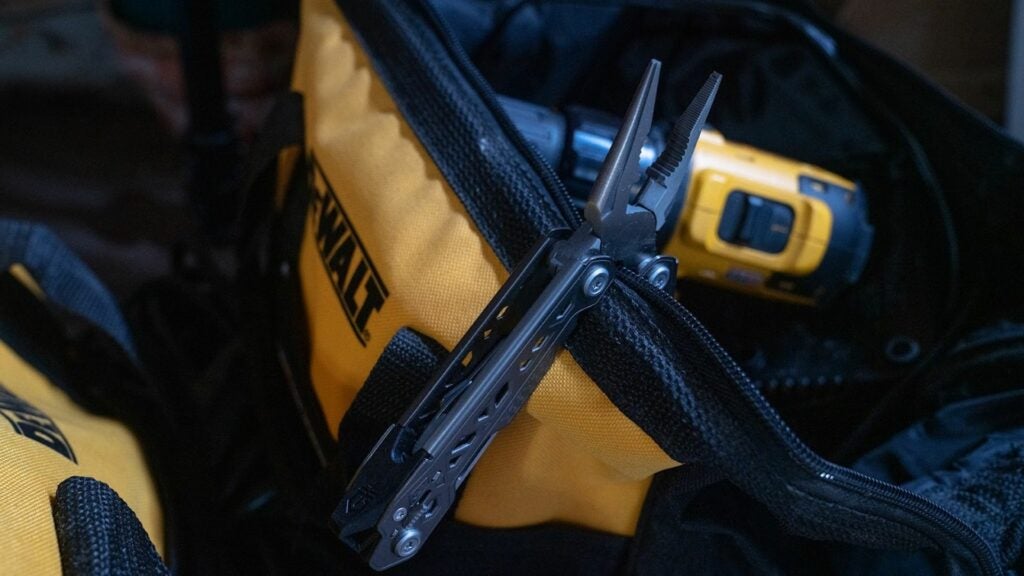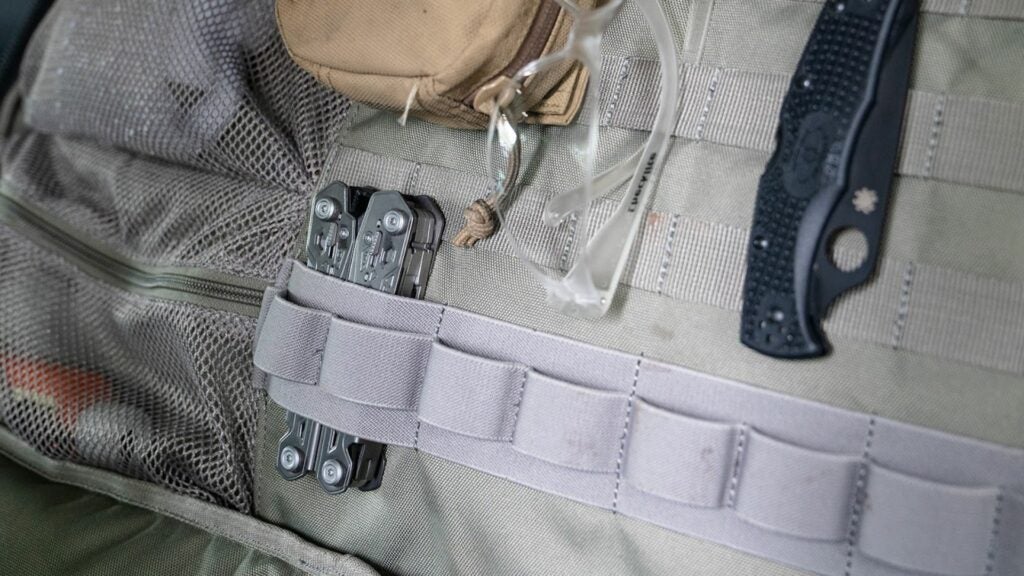When I was a kid, my friends and I spent every free minute roaming around in the woods. We chased turkeys, built forts, and played more games of manhunt and flashlight tag than I can count. As children of the forest, we also loved any gear we could convince our parents to let us use (if there’s a good argument for giving a kid a chainsaw, I sure as hell couldn’t think of it). Even if the motorized good stuff was off-limits, we were eventually blessed with the privilege of carrying pocket knives.
One day, it came to our attention that there was something even cooler than knives: multitools. We didn’t know much, but we understood that bigger was better, regular pocket knives were for old fogies, and Gerber was the shit.
A lot has changed since then, both for my group of menaces and the choices we have when buying gear. Big-name brands like Leatherman, Victorinox, and Gerber can’t get by on brand recognition alone anymore. There are too many new companies making solid tools to coast on past successes. I was happy to see the Gerber Truss at a compelling $50 MSRP but I had to wonder how many corners had been cut to achieve it. Was this a bargain, or a company cheaping out and assuming the logo would take care of business?
Weight: 8.4 oz
Material: Stainless steel
Tools: Spring-loaded needlenose pliers, regular pliers, wire cutter, 2.25 in plain edge blade, 2.25 in serrated edge blade, scissors, saw, scross driver, flathead drivers (small, medium, and large), can opener, bottle opener, awl, file, ruler, wire stripper
Unboxing
The Gerber Truss wasted no time making its intentions known. This multitool is eye-catching, to say the least. With the skeletonized handles, thick stacks of tools, and two-tone steel, it’s clear the designers wanted it to attract attention when shoppers scroll through Amazon or glance into the display case at their local Cabela’s.
The Truss greeted my hand with noticeable weight, as I would expect from a tool intended to withstand hard use in the real world. According to the Gerber website, the entire lineup of products is built using stainless steel. If I hadn’t checked, I might have thought the Truss’ steel was the tool-grade D2 found on many entry-level knives––especially given its price. The coating on the Truss does a good job of muting shine to make it a reasonable choice for tactical use, even in the silver color (matte black is available, too).

The Truss’s tools include multi-use pliers, wire cutters, scissors, two knife blades with and without serration, various screwdrivers, a can opener, bottle opener, saw, file, and awl. Gerber also touts the tool’s ruler, but measurements are only indicated in five-millimeter and quarter-inch increments up to four centimeters, and the shape of the ruler makes it hard to use beyond three centimeters so far that I can’t imagine many situations where that would come in handy. All the tools except the pliers lock in place with ambidextrous safety switches. The pliers are spring-loaded, which is an excellent touch that makes them much easier to operate.
Included with the Truss is a black nylon case. The velcro flap should prevent it from falling out, but keep in mind that noise discipline will be practically non-existent if you need to open it. Belt loops allow the pouch to be mounted vertically or horizontally, but not to MOLLE. Gerber, if you’re reading this, I’m sure your customers would appreciate the ability to mount this to a plate carrier or assault pack.
How we tested the Gerber Truss

As much as I love collecting specialized tools, there are times when a good multitool is right for the job. Maybe that time comes on an aircraft or walking patrol when lugging around a bunch of full-sized tools isn’t realistic. Maybe it’s when you’re suffering your ass off in the attic getting dominated by 50-year-old insulation. I used the Truss for all kinds of odd jobs around the house and garage, but never was it more of a life-saver than when I had to sort out faulty wiring in a ceiling light. Bracing my knees on joists above old plaster and holding up sheets of horrendously itchy insulation with one hand, I was glad to have screwdrivers, pliers, and wire cutters at my fingertips. The Truss was a huge help up there.
Since Gerber’s website is a little vague about the type of stainless steel they use, I was curious about the Truss’ corrosion resistance. As with the last multitool I tested, I planned to soak it in a mixture of water and road salt, then let the tool air dry to give rust an ideal opportunity to do its thing. Right away, I noticed an oil slick on the water’s surface. That wasn’t a good sign because any oil that made its way to the surface wasn’t protecting the tool’s moving parts. Sure enough, a bright orange crust had formed on the metal that had been submerged. All the tools showed some sign of corrosion and the action was noticeably crunchy. One of the locks failed to engage fully, although it did hold the tools in place. A rinse in tap water and a light coat of oil helped, but a few rust spots remained and movement wasn’t what it once was.

Unlike most of the multitools I’ve used, the Truss is held together by Torx screws rather than pins or rivets. That got me thinking: if I could break this thing down like a firearm, I could keep it cleaner and in operational shape much longer. It was a good theory, but the Torx size was unusually small and my standard mechanic’s tool set didn’t have the right bit. The idea is still worth considering, but plan on buying specialized tools to do it.
What we like about the Gerber Truss
For less than $50, I’ll admit that this multitool had a pretty low bar to clear in my book, but the Truss has a feel of quality to it that goes beyond what I’d expect based on the MSRP, let alone the available sale prices. That’s owed to the balance of size and weight. It’s compact enough to cram into a spare magazine pouch, toss in a bug-out bag, or even carry in a pocket.
At the same time, the Truss definitely doesn’t feel cheap. At 8.4 ounces, it’s apparent that this multitool was built to take a beating and there’s not a spec of plastic to be found outside of the lanyard loop. I also like that all the tools open outboard, so users don’t have to mess with unfolding the handle every time they want to get to something besides the pliers.
Finally, a major part of reviewing gear is putting each piece in context regarding price. Would I pay $100 for the Truss like I would for other multitools? Absolutely not––it just can’t justify that kind of premium. Cut that in half, and the prospect of owning one starts to look a lot better. With sale prices dipping to less than $40, it’s hard not to recommend one of these as an entry-level tool for beginners or a knock-around backup for those of us with an existing collection. It’s worth reiterating that this is inexpensive; not cheap.

What we don’t like about the Gerber Truss
As always, there’s room for improvement. If you plan on using this as more of a tactical tool than an EDC item, there are some things you’ll want to pay attention to.
The most glaring problem with the Truss was its performance in my corrosion test. It’s honestly what I expect from a $50 multitool, and Gerber specifically warns against contact with saltwater in the FAQ section of its website. My experiment was meant to torture the Truss and I definitely pushed it further than any responsible owner should. Still, other (albeit more expensive) multitools have aced the same test.
Gerber has positioned itself in recent years as a tactical brand aimed at serving military, law enforcement, and first responder customers in addition to civilians and outdoor enthusiasts. One thing I look for in tools intended to perform in that world is the ability to use them with gloves. Many military units require service members to wear gloves, and it’s important to account for inclement weather. As easy as the Truss is to use, it’s a bit of a hassle with gloves on. You might have luck getting to the pliers and outermost tools (both knives, the saw, and scissors), but everything else requires a fingernail. That’s not a deal-breaker and it certainly isn’t limited to this particular multitool, but it’s worth mentioning.
My other gripes are subjective. For one, I could do without some of the over-the-top styling. I understand what a truss is in the engineering world, but the shapes on the side of the multitool aren’t trusses; they’re cutouts to (presumably) reduce weight. I don’t know how much weight they actually save, but I’d rather have it than pay for the designers who spent untold hours deciding what shapes to carve into this thing.
That brings me to the name. If there’s a connection here, maybe Gerber can make it more clear because it seems rather arbitrary. Again, these are personal complaints and you may disagree. If you do, go ahead and snatch one of these up because the Truss is still a useful tool and a considerable bargain.
Verdict
After using the Truss with success and subsequently pushing it very near the brink of failure, where does it stack up? Well, it’s a classic case of getting what you pay for. I could go on about how Gerber designed it to look cool instead of using that money to improve functionality, whine because it’s not more corrosion-resistant, or point out that there are multitools I’d rather carry. Those are all valid points, but they don’t paint the whole picture.
The Truss is also a solid bargain. Most of the people who use one will never bring it near the ocean or abuse it with road salt, and they’ll probably be very happy with their purchase. If you demand the best there is, keep saving your money. If you need something affordable to get the job done and don’t mind doing a little preventative maintenance, carry on. I won’t get in your way.
Saved rounds
For a while, Gerber seemed like one of the biggest names in the business. As far as my childhood friends and I were concerned, having a Gerber knife meant you were serious about tactical gear and either worked in some kind of kinetic environment or (like us) watched enough Discovery Channel documentaries to know what those people carried. These days, things aren’t so simple. The competition has gotten much stiffer and I don’t necessarily have the same level of expectations from the brand as I might in, say, Spyderco or Victorinox. That’s partially because those brands are very up-front about the types of steel they use and the research and development they’ve done.
FAQs about the Gerber Truss
More questions? Here’s Task & Purpose’s additional brief.
Q. How much does the Gerber Truss cost?
A. Gerber lists an MSRP of $50 for the Truss, but we found a smoking deal that will let you have one for $39.99.
Q. What tools are included?
A. The Truss offers all the tools you’d expect from a quality multitool. It includes spring-loaded pliers, scissors, two flathead screwdrivers, a Phillips head screwdriver, wire cutter, wire stripper, saw, serrated blade, traditional blade, can opener, bottle opener, awl, (tiny) ruler, and file. There’s also a lanyard loop tucked out of the way for those of you who like to keep your gear dummy-corded.
Q. What kind of metal does Gerber use to build the Truss?
A. Gerber doesn’t specify what kind of steel they use, but they describe it as “100 percent high-grade stainless steel.” That’s good, but not terribly helpful. This information is also buried in the website’s FAQ section, which can only be found by scrolling all the way down to the footer. If I were building products from top-shelf materials, I’d plaster the specs on every product page I had.
Q. How does this multitool stack up against the competition?
A. I’d say that the Truss holds its own in the multitool market well. There are certainly more robust options out there — including very specialized tools — and I can tell that Gerber was aiming for a price point that would keep it accessible. Still, I think the Truss performs above Gerber’s asking price. For an entry-level multitool, it’s a decent choice.
Q. What the hell is a truss, anyway?
A. Truss is an engineering term used to describe a structure made of rigid material joined at the ends to achieve strength through mutual support. You can see this kind of thing on bridges or in your attic, where metal or wood beams form triangles to make the structure more capable of bearing heavy loads while remaining relatively light. What’s that got to do with a multitool? Hell if I know.
We’re here to be expert operators in everything How-To related. Use us, compliment us, tell us we’ve gone full FUBAR. Comment below and let’s talk! You can also shout at us on Twitter or Instagram.
Scott Murdock is a Marine Corps veteran and contributor to Task & Purpose. He’s selflessly committed himself to experience the best gear, gadgets, stories, and alcoholic beverages in the service of you, the reader.
Task & Purpose and its partners may earn a commission if you purchase a product through one of our links. Learn more about our product review process.
